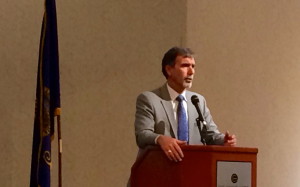 The four-day school schedule is a policy born of hard times.
The four-day school schedule is a policy born of hard times.
Not that it has made hard times much better.
Nationally, school districts first adopted the schedule in the 1930s, during the Great Depression. The policy grew more popular in the 1970s, during the energy crisis.
Then came the Great Recession. The number of Idaho four-day districts went from 10 in 2006-07 to 43 in 2015-16. In many cases, administrators jettisoned classroom days in hopes of stretching scarce dollars.
For many districts, the savings turned out to be modest at best.
‘Elusive’ savings

When trustees in the Magic Valley’s Hagerman School District adopted a four-day calendar in April of this year, the budget was one driving factor. A few weeks into the change, Superintendent Eric Anderson is expecting to trim his budget by 4 percent.
That’s not out of the ballpark, because results vary widely.
North Idaho’s Boundary County uses the four-day schedule to trim about 10 percent from its budget. Those savings make it difficult to consider returning to a five-day schedule, Superintendent Gary Pflueger said.
Eastern Idaho’s Soda Springs District went to a four-day calendar in 2006, as part of a larger austerity plan that included the consolidation of two elementary schools, shutting down a one-room school and closing an alternative school. The four-day schedule saved about $50,000, less than 1 percent of a $5.8 million budget, Superintendent Molly Stein said.
A few miles from Soda Springs, the Grace School District Superintendent Jamie Holyoak pegs the annual savings at $30,000 — again, less than 1 percent of a $3.6 million annual budget.
The modest savings are consistent with the research.
In May 2011, in the throes of the Great Recession, the Denver-based Education Commission of the States compiled a report designed to tell districts what to expect from a shift to a four-day schedule. On the high end, districts could cut about 5.4 percent from their budgets — a rate Boundary County exceeded. A more realistic expectation, said the ECS report, would be 0.4 to 2.5 percent savings.
A July 2015 report, commissioned by the Rural Opportunities Consortium of Idaho, was even more pessimistic. “Though cost cutting was the original motivation for the four-day week, savings have been elusive in most locations,” the study said.
Some expenses offset savings, according to the report. Districts still have to heat schools on Fridays, since teachers come in to train or provide extra help for students. Districts also have to buy and prepare snacks to help kids get through the longer school day.
Limited options
Teacher salaries and benefits account for the vast majority of any district’s budget. And the need for teachers is driven not by a school calendar, but by student enrollment. According to the ECS study, four-day districts can expect to save no more than .03 percent on teacher salaries — or $300 per $1 million in payroll.
Districts cut costs when they keep buses off the road on Fridays, but they don’t see much of the savings. In Idaho, the state reimburses 85 percent of a district’s transportation costs. Therefore, transportation savings benefit the state far more than the districts.
That leaves only one big source of savings: cutting hours for classified staff, such as bus drivers, custodians and cafeteria workers. For superintendents — often the CEO of a town’s largest employer — this presents a gut-wrenching decision.

“To save the money, you have to do that on the backs of your classified staff,” said Ed Schumacher, superintendent of the Cambridge School District, which adopted the four-day schedule in 2010-11. “We didn’t go out of our way to capture every dollar.”
Cambridge couldn’t do much to save bus drivers’ hours, but it absorbed some classified jobs. The remaining employees’ hours remained intact.
When the Shoshone School District went to a four-day schedule in 2011-12, Superintendent Rob Waite decided to phase in savings. He grandfathered in the existing classified employees — but when they left, he hired part-time replacements. He has moved 33 employees to part-time hours, saving more than $200,000 for a district with an annual budget of $3.5 million.
Waite often meets with fellow administrators considering the switch to a four-day calendar. His advice: They need to scrutinize all potential savings before making a decision. And that includes employee hours.
Said Waite: “I totally realize they’re tough conversations to have.”
Rubbing nickels and dimes together
Perched against some of Idaho’s tallest and most jagged mountain peaks, Central Idaho’s Mackay School District is no stranger to tough conversations. In 2013, Mackay became a poster child in a heated Statehouse debate over school funding. Mackay supported a bill to allow districts to cut teaching staff or contract days, because it wanted to cut teacher salaries by 5 percent. Mackay’s staff endorsed this $150,000 spending cut, desiged to match a voter-approved supplemental property tax levy. The bill passed.
As a result of the four-day calendar, Mackay has cut classified staff hours by one fifth, and not just to cut payroll. The district also saves on benefits, since classified employees are no longer eligible for health insurance. They instead seek coverage through their spouse, or through the state’s health insurance exchange, said Superintendent Leigh Patterson.
For a district that still struggles to get voter support for levies, even modest savings matter. “We’re taking nickels and dimes and rubbing them together,” said Michelle Peterson, who teaches fifth-grade and music in Mackay’s elementary school. “The struggle is real in rural Idaho.”
The larger budget debate
As a retired school librarian — and as co-chair of the Legislature’s budget-writing Joint Finance-Appropriations Committee — Rep. Maxine Bell watched closely as schools in her part of the state moved to the four-day calendar. The change was incremental and she found it alarming.
“I felt embarrassed,” said Bell, R-Jerome. “I felt responsible for the fact that they did not have the funding.”
Several years later, Bell still sees the four-day issue as, first and foremost, a fiscal issue. She sees it as a sign of deficiencies in the state’s school funding formula. And she isn’t alone, even within Idaho Republican circles.
During the 2014 elections, state superintendent’s candidate Sherri Ybarra pointed to the four-day schools as evidence of inadequate funding. Gov. Butch Otter said he wanted to restore school funding and make four-day schools a thing of the past.
Both were elected — Ybarra to a first term, Otter a third. Now, both describe four-day schools as a matter of local control — and in a recent interview, Otter said it is important to restore funding for the benefit of all schools.
For four-day schools, of course, the financial realities are more complicated than the political rhetoric suggests. The savings from the four-day switch are critical for some districts, inconsequential for others.

Rob Winslow, executive director of the Idaho Association of School Administrators, sees the four-day school movement in the context of larger fiscal challenges. All districts struggled with state budget cuts. Some districts struggled to pass supplemental levies. Other districts tried to go without them.
Winslow doesn’t expect to see districts abandon the four-day calendar any time soon. However, increased state funding would allow administrators and trustees to take a more nuanced look at the school calendar and school levies. This year’s 7.4 percent budget increase for K-12 is a start — but only a start.
“It’s going to take a while to get there,” he said.
Disclosure: The Rural Opportunities Consortium of Idaho is funded by the J.A. and Kathryn Albertson Family Foundation, which also funds Idaho Education News.
“Rescheduled Education” is the product of a partnership between Idaho Education News and Idaho Public Television. Reporting on the series are Kevin Richert and Clark Corbin of Idaho Education News and Seth Ogilvie and Melissa Davlin of Idaho Public Television. Video producers are Andrew Reed of Idaho Education News and Troy Shreve of Idaho Public Television. Idaho Education News data analyst Randy Schrader compiled data for the series.
‘Rescheduled Education’ at a glance
Day One, Monday, Nov. 16
An unproven experiment, involving 26,881 Idaho students
Data dive: Surprising statistics on four-day schools
Day Two, Tuesday, Nov. 17
Four-day school test scores are inconclusive — but troubling
Sage and COSSA Academy: Two four-day outliers
Day Three, Wednesday, Nov. 18
A schedule change saves money. Just not much.
Preston upholds a decision driven by dollars
Day Four, Thursday, Nov. 19
Teachers and students adjust to longer school days
‘No time to waste:’ Notus runs at a fast pace
Day Five, Tuesday, Nov. 20
Across rural Idaho, four-day weeks become routine
Challis embraces change — but with reservations
Uncomfortable questions, unclear answers on social impacts (Idaho Reports blog)
